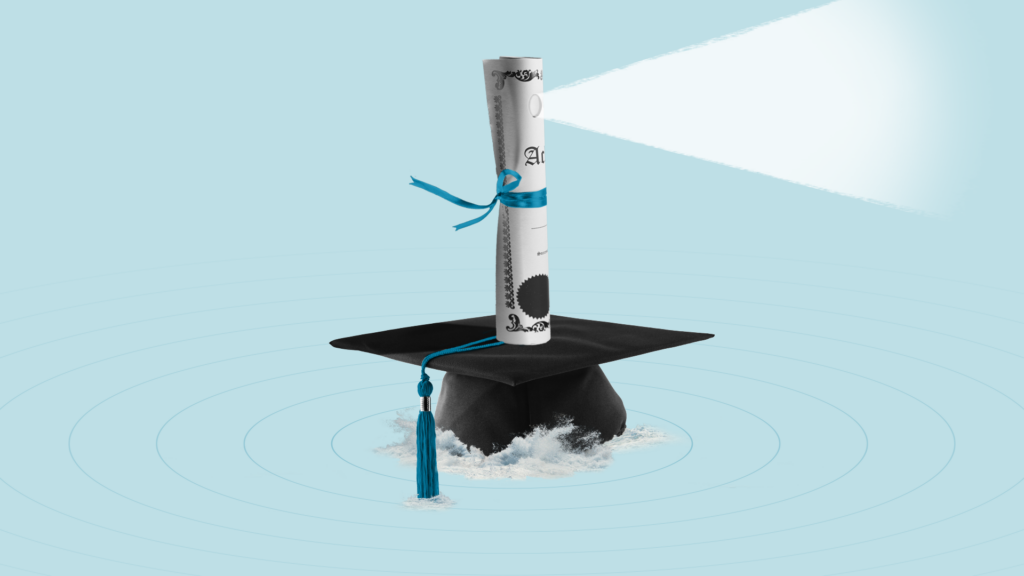Students and faculty alike are demanding more from their universities, specifically more efficiency and flexibility. Technology would seem to be the answer, but with all the available options, finding the right fit can be like finding a needle in a haystack. Instead of focusing on technology as the end-all, be-all solution to every problem, university leaders must embrace an agile mindset that centers operations around the needs of their students and use technology to support their goals and overcome their obstacles.
- What is an agile university?
- When is agility the right strategy?
- 5 Steps to Develop Your Own Agile Strategy
What is an agile university?
Agile universities are flexible, responsive, and efficient. They relentlessly dismantle processes, systems, and tooling that make it harder for their students and faculty to operate. Instead of basing operational systems on modalities and the specifics of individual program offerings, these institutions put their students and faculty at the heart of everything they do.
For too long, institutions have treated their online and campus-based programs as siloed and separate entities. Agile universities understand the procedural inefficiencies and experiential obstacles of that approach and instead look to combine these two programs as much as possible to create a space that their students and faculty can seamlessly enjoy and take ownership of.
When is agility the right strategy?
Students and faculty have higher expectations for their university experiences than ever before. Between the advancements in technology and recent cultural shifts towards diversity and flexibility, institutions are struggling to keep up with the rate of change demanded.
An agile approach is the answer to this problem.
When your online degree programs have the same standards and goals as on-campus programs, an agile approach builds bridges between them, creating a seamless experience for students and faculty by simplifying processes, eliminating redundancies, and centering institutional operations on the students.
But there are always exceptions. If your online initiatives are nondegree, completely asynchronous, or target a group that has significantly different goals than your typical learners, it’s possible that keeping your programs siloed is the best option.
An agile mindset puts the emphasis on the student experience, and its practical application will look different for every institution. Just because you haven’t merged your programs doesn’t mean you aren’t following agile tenets and principles.
5 Steps to Develop Your Own Agile Strategy
While there are many ways to implement an agile strategy, there are five key categories you should evaluate as you develop yours:
- Defining your goals
- Understanding the economics of your institution
- Designing your learning programs
- Developing your marketing, recruiting, and retention engines
- Understanding your capacity and available resources
Defining Your Goals
Your institution has two primary goals: educating students to the best of your ability and establishing opportunities to build connection and community.
What are the best formats for your learning programs?
How you present information is often more important than the information you’re trying to present. Some students learn best in seminar-style lectures, others need real-world application, and still others prefer an asynchronous, learn-on-your-own-time approach. When building your agile strategy, prioritize the modalities and formats of your learning programs based on delivering the best outcomes for your students and faculty. A few considerations:
- Can you build in practicum-style learning even in early-stage courses?
- Are some courses better suited to asynchronous learning?
- Are there local businesses you could partner with for your learning program?
There are endless ways to structure your learning programs—finding the formats that work best for your students and faculty is the challenge. Start by asking your faculty if they have ideas for better formatting their curriculums. Then ask your students.
Today’s students are engrossed in technology; for good or bad, it’s how they experience and interact with the world around them. It fundamentally changes how, when, where, and why they want to learn. Don’t just encourage the use of technology across your campuses; find new ways to integrate it into individual learning programs.
How do you create community for both campus-based and online students?
Universities have largely succeeded in developing community throughout their physical campuses. Between sports programs and events, student government, identity centers, and other extracurricular groups, on-campus students have ample opportunities to meet other people and build lasting relationships. The challenge is bringing those same opportunities to online and hybrid students.
Additionally, the latest national College Health Assessment found that about a third of students have an anxiety diagnosis, and nearly a quarter have a depression diagnosis. This generation of students is hyper-aware of the impacts of mental health on their day-to-day wellbeing, and actively seek out institutions that support their mental health goals.
Consider establishing systems that help online and hybrid students intentionally build their support network like non-traditional on-campus activities, a holistic approach to advising, and digital peer-to-peer support programs.
Understanding the Economics of Your Institution
One great thing about an agile strategy is that your enrollment goals aren’t limited by your physical campus. When you build a strategy that allows for a number of different on- and off-campus experiences, you’re giving yourself the freedom to dream a little bigger; you decide how many students you actually want to enroll each year and then build your systems accordingly.
But that’s also a double-edged sword. It wouldn’t be outside the realm of possibility to enroll double the amount of students that your physical campus can accommodate. The challenge becomes how to create community when you don’t have a space big enough for everyone to come together.
While you don’t have to stop setting stretch goals for enrollment, you do need to be realistic. Enrolling more students than you have physical capacity for creates its own problems that you will have to address.
Read Inside Higher Ed’s interview with John KatzmanDesigning Your Learning Programs
In a recent interview, Noodle’s CEO and Co-Founder, John Katzman, said:
“Home Depot doesn’t care if you buy a hammer online or in a store. Its operations are agile and integrated, from merchandising to marketing to returns. It’s just trying to serve you efficiently and responsively.”
Universities and colleges should take a page from the retail industry when it comes to designing student learning experiences. Your goal should be to provide one cohesive experience for all of your students no matter how they interact with your institution.
Why do you care if your students want to consume your courses online or in person? The information doesn’t change. Offering your courses in multiple formats like online or asynchronous increases engagement and retention by making allowances for more diverse backgrounds and disabilities.
But it’s not just the format of your learning programs you should consider. Ask questions that determine whether your programs as a whole benefit your students, prospective students, and their future employers.
- Is your curriculum still applicable to the real-world scenarios your students face after graduation?
- Are your programs too specialized or not specialized enough for the job market?
- Do your students understand your programs at a macro scale and why they’re taking the courses you require?
When designing your learning programs, your goal should be to serve your students and faculty efficiently and responsively. Meeting this demand for flexibility—while providing top-notch value for students pursuing specific careers—leads to better retention rates and to both students and faculty feeling a sense of ownership over their time with your institution.
Developing your marketing, recruiting, and retention engines
Agile strategies are inherently rapid-paced and ever-evolving. Embrace that methodology when building your marketing, recruiting, and retention strategies to create more effective marketing strategies.
When you’re doing your market analysis, don’t just look at your learner demographics. Broaden your scope to include job market trends and fluctuations to help you get ahead of demand for specific degree programs and pivot programs for careers that are on their way out. Ask yourself:
- Which jobs are most in demand in your region?
- What industry trends will impact job growth or decline in the next five years?
- What job requirements must job seekers have to qualify for roles in your region?
Not only does looking at how businesses are hiring your learners help to identify potential growth or decline in demand for your programs, but it also helps you maintain your balance between degree and nondegree programs as more industries forego formal degrees in favor of certifications and real-world experience.
Understanding Your Capacity And Available Resources
The key to agile success is knowing, working within, and optimizing your existing organizational structures to quickly respond to the ever-changing needs of your students and faculty. These structures allow you to capture, ideate, and implement changes when and where students and faculty need. When not efficient or designed for 21st century learning, they make responding to market changes more difficult than it needs to be.
Auditing these organizational structures requires you look at:
- Your disciplinary strengths and aspirations
- How they’re prioritized among other key initiatives
- The operations at which you excel
- Where you can supplement in-house teams with agencies or partners
- How you collaborate with other universities to improve outcomes and lower costs
By focusing on structure, you give yourself the opportunity to align teams across your organization to offer a cohesive and holistic learning experience to all your students. It also offers a better overall picture of individual students’ obstacles and goals, so your advisors can help them quickly and efficiently conquer roadblocks.
Conclusion
By prioritizing student-centric strategies and integrating online and on-campus experiences, institutions can unlock endless opportunities for growth. Embrace agility, redefine learning paradigms, and chart a course towards unparalleled success. Ready to start on your agile university strategy? Let us collaborate with you to craft a custom solution tailored to your institution’s unique needs.



